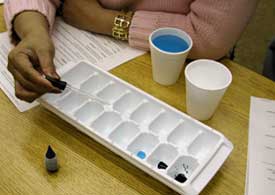|
|
||
Mass ExtinctionsOf all the species that have ever lived, 99% are now extinct; therefore extinctions are quite common. However, there have been at least six times during Earth's history when a significant percentage of the existing organisms have gone extinct. Such events are referred to as mass extinctions and are caused by a global change of the environment and the failure of species to adapt at a rate equal to or greater than the rate of that change. Perhaps one of the most famous mass extinction occurred at the end of the Cretaceous, during which the dominant land vertebrates, in particular the dinosaurs, went extinct. Though the exact cause of this extinction is not certain, the occurrence of a large asteroid impact certainly played a significant role. Discussion: Examining the potential effects of an asteroid impact |
||
The Electromagnetic SpectrumBefore beginning a discussion of the atmosphere, ozone and greenhouse gases, teachers reviewed the electromagnetic spectrum. Discussion: The Electromagnetic Spectrum |
||
Learning About the OzoneFollowing a review of the divisions of the Earth's atmosphere, teachers learned about the importance of the ozone layer. Discussion: Learning about the OzoneActivity: Whole
Body Ozone Chemistry Activity: The
Ultraviolet Project Chemistry |
||
Greenhouse Effect and Global WarmingEarth is habitable because of the 'greenhouse effect' but an enhanced greenhouse effect can be associated with the trend in global warming. Discussion: Greenhouse Effect and Global WarmingActivity: The
Greenhouse Effect in a Jar
Activity: Human
Activity and Climate Change Activity: Introduction
- Greenhouse Gases |
||
Additional ResourcesEducational Resources of the US Environmental Protection Agency Greenhouse Effect and Global Warming LEARN:
Atmospheric Science Explorers Global
Warming & The Greenhouse Effect |
||
| Updated January 5, 2003 Home | What's new | About UCMP | History of Life | Collections | Subway |
